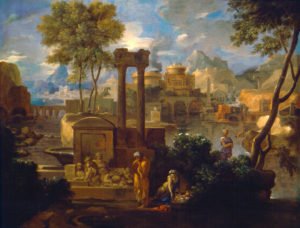Object of the Month: May 2015
The Hiding of Moses
Oil on canvas
Sébastien Bourdon
French, 1616–1671
Click on the links throughout the article to view additional artists’ works and reference material.
Background:
Born in 1616, Sébastien Bourdon was part of the bourgeoning French Baroque movement of the seventeenth century. Embroiled in intense and divisive political upheavals throughout much of the fifteenth century, French painters took a decided second place to the painters of the Italian Renaissance; however, during the sixteenth century, French artists began to reestablish their international prestige, with many French artists traveling to Rome to increase their artistic knowledge and abilities. Within this group, Bourdon deserves special attention for the wide range of artists he imitated and the immense stylistic variety he cultivated within his paintings.
History and Influences:
Born in Montpellier to a strict Calvinist family, Bourdon visited Rome in 1636, where he would study the styles of famed artists ranging from Dutch Golden Age painter Pieter van Laer (Il Bamboccio) to fellow-Frenchman Nicolas Poussin. The latter artist would have a particularly profound influence on Bourdon, with his emphasis on classical landscapes, carefully-ordered lines, and Platonic ideals, characteristics all present in Bourdon’s The Hiding of Moses. Unfortunately, Bourdon’s stay in Rome was cut short in 1638, as he was “forced to flee the Eternal City…after being denounced by the Catholic Inquisition as a heretic.” Upon returning to France, Bourdon would become a court painter to King Louis XIV and play a pivotal role in the 1648 founding of the French Royal Academy of Painting and Sculpture.
The Painting:
Acquired in 1955, The Hiding of Moses reflects Bourdon’s strong Poussinist influence. Classic architectural elements dominate the landscape, with the arches of bridges, the statute of a horse, an obelisk, and a dais with a sphere placed on it all work together to recreate an environment from antiquity. Taken together, these “elements combine to form an urban scene of man-made constructs,” through which the painter “was undoubtedly trying to give this landscape a Roman mood.”
Paintings of Moses being discovered and pulled from the Nile are quite common among Baroque subjects, but Bourdon’s visual narrative is highly unique in that Moses is actually being placed into his basket by his birth-mother, as his grieving father looks on. As M&G curator John Nolan notes, this depiction “is much rarer than the typical scene of Pharaoh’s daughter finding Moses.” It is possible that Bourdon’s unique portrayal of Moses contained a deeply personal meaning for the painter, as his own flight from persecution in 1638 would have formed a vivid part of his personal history.
Bourdon’s outstanding portrayal of The Hiding of Moses is part of the collection at the Museum & Gallery.
Blaine Welgraven, Grant Specialist
Published in 2015
